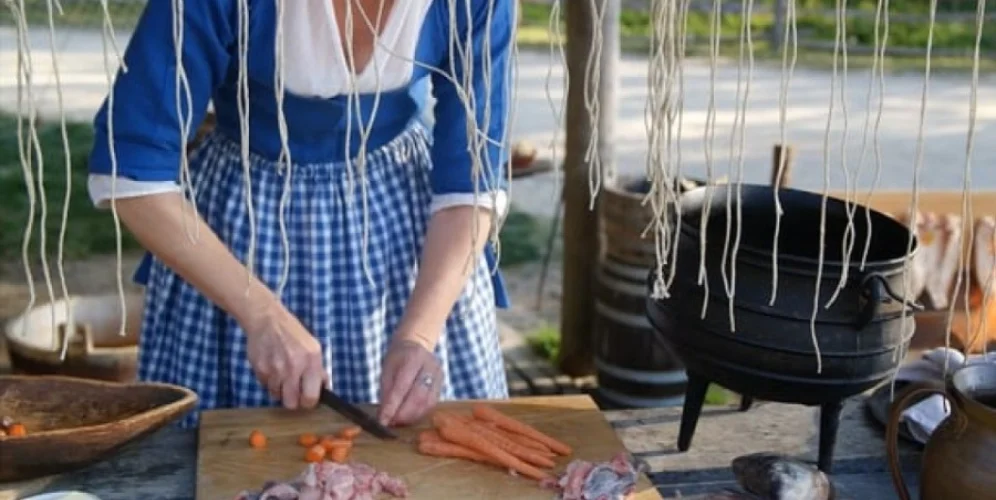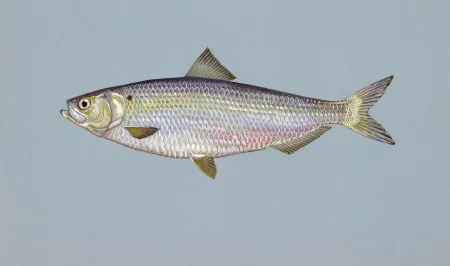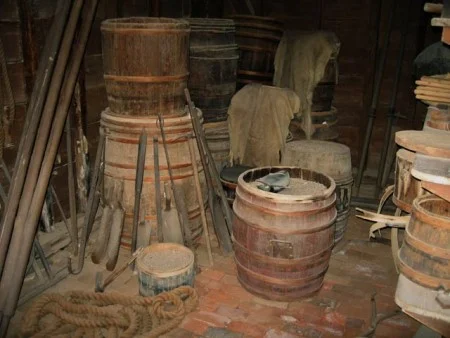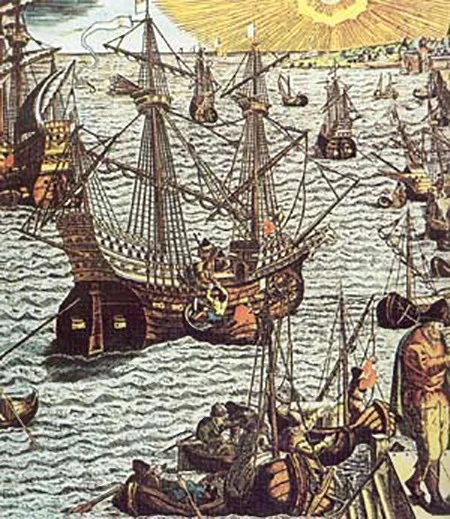One of the most difficult logistic aspects of the fisheries operation involved the salt preservation.
A Very Hectic, Very Short Fishing Season
The most significant problem in this emerging fishing industry was the fact that the peak season for harvesting occurred in a very, very short period of time. This, combined with the labor-intensive effort required to clean, preserve, and pack the fish in barrels, made the five or six-week fish run a very hectic time. Huge quantities of salt were needed for preserving the herring. Sufficient barrels and storage sheds were needed for the processed fish. There was also the effort involved with disposal of the byproducts of cleaning the fish.
Shad Cooking
Historic Trades Interpreter, Deborah Colburn, shows us how shad was used in a variety of meals at Mount Vernon among the enslaved workers.
Watch the videoCatching and Preseving Herring
Herring form in schools, like a large ball of fish. Washington's workers used small inch mesh so that the herring would be trapped, not gillnetted. Other larger fish could move to the outer areas of the seine and escape through the larger mesh in the wings.
Learn more about seine fishing
These herring were the common blueback. In Washington's time, they were about 15 to 18 inches in length and about ¾ pound in weight.
Once the fish were removed from the net, they were brought to tables where the fish heads were removed and the fish were drawn, the innards being removed. They were rinsed in a brine solution and then packed in barrels, about 800 to a barrel with alternating layers of fish and salt. The fish were packed head to tail, similar to what you see when you open a can of sardines, only with the backs down and the open stomachs up, rather than flat. This allowed the stomach cavity to be filled with salt.
The combined weight of fish and salt tended to compress the packing and excess water was poured off as it collected on top. Then the barrels were moved to storage.
Surprisingly, this method of preservation allowed the fish to remain edible for incredibly long periods of time, well in excess of a year. An archaeological investigation in 1991 of the cargo of a sailing vessel that sank in 1830 revealed some herring packed in this method had remained in edible condition.
George Washington's Salt House
Learn about George Washington's salt house, which held vast quantities of salt for preserving the fish and provided additional storage space for an assortment of fishing equipment.
Imported Salt from Europe
The Best, from Lisbon, Portugal
Another issue was availability. Why did the kind of salt used matter? The best and only really acceptable salt was Lisbon salt. It was made by flooding large land areas with salt water, allowing the sun to evaporate the water and leaving the salt, a slow process. This provided a product that was stable and did not hydrate or draw up moisture rapidly. Thus it did not melt easily in contact with, for example, wet herring. It preserved well, was easily transported, and easily stored.
This salt was very difficult to come by because it had to be imported from Libson, Portugal. However, because of English law, Virginia and the other southern colonies were unable to import Lisbon salt directly. If a Virginia ship took a cargo to Lisbon, traded and bought salt, the ship had to sail to England, clear customs, pay duty on the salt, then sail for the colonies. Many times the salt was required to be delivered first to a northern colony for transshipment to Virginia. This added to the time for delivery and substantially increased the cost.
This problem originated with the English merchants who had a large and highly lucrative dried salt cod business with the northern colonies and had strong support in the House of Commons. By controlling the importation of Lisbon salt into the colonies, they protected their northern fisheries.
The Cheaper Alternative, from Liverpool, England
The salt from Liverpool, England, in contrast, was made by boiling sea water and resulted in a salt not much different from that in use today, although much more crude. This salt was allowed to enter the southern colonies and was preferred for domestic use.
However, it was found, by long experience in warm climates, to be too weak to accomplish preservation. The fish or meat preserved or cured with it turned rusty in color and, in six or eight months, was unfit for eating. By reason of the impurities left by the evaporative boiling process, it was so corrosive that meat lost its fat content and the remaining lean hardened and was of little value. These same difficulties were evident in its use with fish.
George Washington's Fisheries
No endeavor better represented Washington’s entrepreneurial spirit than his three fisheries along the Potomac River spanning his 10 miles of coastline at Mount Vernon.
Learn more



